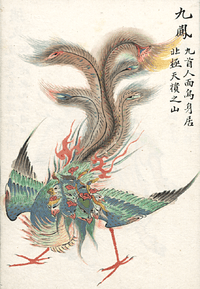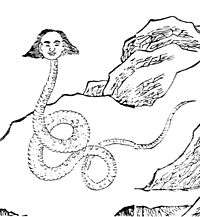Classic of Mountains and Seas
| Classic of Mountains and Seas | |||||||||||||
| Traditional Chinese | 山海經 | ||||||||||||
|---|---|---|---|---|---|---|---|---|---|---|---|---|---|
| Simplified Chinese | 山海经 | ||||||||||||
| Literal meaning | Classic of Mountains and Seas | ||||||||||||
| |||||||||||||


The Classic of Mountains and Seas or Shan Hai Jing,[1] formerly romanized as the Shan-hai Ching, is a Chinese classic text and a compilation of mythic geography[2][3] and myth. Versions of the text have existed since the 4th century BC,[4][5] but the present form was not reached until the early Han dynasty a few centuries later.[5] It is largely a fabulous geographical and cultural account of pre-Qin China as well as a collection of Chinese mythology. The book is divided into eighteen sections; it describes over 550 mountains and 300 channels.
Authorship
The exact author(s) of the book and the time it was written are still undetermined. It was originally thought that mythical figures such as Yu the Great or Boyi wrote the book. However, the consensus among modern Sinologists is that the book was not written at a single time by a single author, but rather by numerous people from the period of the Warring States to the beginning of the Han dynasty.
The first known editor of the Classic was Liu Xiang from the Western Han, who among other things cataloged the Han imperial library. Later, Guo Pu, a scholar from the Western Jin, further annotated the work.
Overview
The book is not a narrative, as the "plot" involves detailed descriptions of locations in the cardinal directions of the Mountains, Regions Beyond Seas, Regions Within Seas, and Wilderness. The descriptions are usually of medicines, animals, and geological features. Many descriptions are very mundane, and an equal number are fanciful or strange. Each chapter follows roughly the same formula, and the whole book is repetitious in this way.
It contains many short myths, and most rarely exceed a paragraph. A famous ancient Chinese myth from this book is that of Yu the Great, who spent years trying to control the deluge. The account of him is in the last chapter, chapter 18, in the 2nd to last paragraph (roughly verse 40). This account is a much more fanciful account than the depiction of him in the Classic of History.
Purpose
Earlier Chinese scholars referred to it as a bestiary, but apparently assumed it was accurate. In fact the information in the book is mythological. It is not known why it was written or how it came to be viewed as an accurate geography book.
Contents
The Classic of Mountains and Rivers has 18 chapters (巻). Chapter 4 has 12 subsections (次一), 2 and 4 have four, and chapters 1 and 3 have three.
| Chapter | Chinese | Pinyin | Translation |
|---|---|---|---|
| 1 | 南山經 | Nanshan jing | Classic of the Mountains: South |
| 2 | 西山經 | Xishan jing | Classic of the Mountains: West |
| 3 | 北山經 | Beishan jing | Classic of the Mountains: North |
| 4 | 東山經 | Dongshan jing | Classic of the Mountains: East |
| 5 | 中山經 | Zhongshan jing | Classic of the Mountains: Central |
| 6 | 海外南經 | Haiwainan jing | Classic of Regions Beyond the Seas: South |
| 7 | 海外西經 | Haiwaixi jing | Classic of Regions Beyond the Seas: West |
| 8 | 海外北經 | Haiwaibei jing | Classic of Regions Beyond the Seas: North |
| 9 | 海外東經 | Haiwaidong jing | Classic of Regions Beyond the Seas: East |
| 10 | 海內南經 | Haineinan jing | Classic of Regions Within the Seas: South |
| 11 | 海內西經 | Haineixi jing | Classic of Regions Within the Seas: West |
| 12 | 海內北經 | Haineibei jing | Classic of Regions Within the Seas: North |
| 13 | 海內東經 | Haineidong jing | Classic of Regions Within the Seas: East |
| 14 | 大荒東經 | Dahuangdong jing | Classic of the Great Wilderness: East |
| 15 | 大荒南經 | Dahuangnan jing | Classic of the Great Wilderness: South |
| 16 | 大荒西經 | Dahuangxi jing | Classic of the Great Wilderness: West |
| 17 | 大荒北經 | Dahuangbei jing | Classic of the Great Wilderness: North |
| 18 | 海內經 | Hainei jing | Classic of Regions Within the Seas |
All 18 chapters can be classified into 4 categories: Classic of the Mountains (contents 5 chapters), Classic of the Seas (contents 8 chapters), Classic of the Great Wilderness (contents 4 chapters), and Classic of Regions Within the Seas (contents 1 chapter). It recorded more than 100 diplomatically related realms, 550 mountains and 300 rivers, along with the geographic and cultural information of the nearby realms. The Classic of Mountains and Seas also recorded up to 277 different animals. Scholars believe the records of animals in Classic of the Mountains are somewhat exaggerated due to the long history of people compiling them in different dynasties; yet they still have a certain degree of authority, because they were generally written by sorcerers and Fangshi based on the experiences they gained from their trips.
The ancient Chinese treated the Classic as a record of geography.[6] The Classic was classified under the category of geography in both Book of Sui and Comprehensive Examination of Literature of Duanlin Ma. It was also an important reference material of Chinese historians through the long history of China.
The Classic of Mountains and Seas is also the source and origin of the ancient Chinese mythology. Some of them are popular and well known in Asian culture, such as Kua Fu, Nüwa, Houyi and Yellow Emperor. There were up to 450 gods and deities mentioned in Classic and they used something called Jingmi (精米) or Jing (糈) which is similar to sorcery.
Chinese scholar Ming Hua Zhang claimed that the Zhulong, which was a mythical creature mentioned in Classic of the Great Wilderness: North, is symbolizing the aurora (northern light).[7] The Zhulong is (according to Classic) "red, with a human face and a snake body that is thousand mile long. It is the god of Zhong Mountain." He believes that this description matches with the characteristics of aurora.
See also
| Chinese Wikisource has original text related to this article: |
![]() Media related to Shan Hai Jing at Wikimedia Commons
Media related to Shan Hai Jing at Wikimedia Commons
- Bai Ze - titular figure of the lost treatise on demonology which has similarities to some of the Shanhaijing.
- Shi Yi Ji (拾遺记) by Wang Jia - a 4th-century work containing "apocryphal" versions of some of the stories in the Classic of Mountains and Seas.
Notes
- ↑ "Chinese Text Project". http://ctext.org/shan-hai-jing. External link in
|website=(help); - ↑ Lewis, Mark Edward (2006). The Flood Myths of Early China. State University of New York. p. 64. ISBN 978-0-7914-6663-6.
- ↑ Mark Edward Lewis (2009). China's Cosmopolitan Empire: the Tang dynasty, Vol. 4 (illustrated ed.). Harvard University Press. p. 202. ISBN 0-674-03306-X. Retrieved February 2012 8. Check date values in:
|access-date=(help) - ↑ Leo Bagrow, R. & A. Skelton (2009). History of cartography. Transaction Publishers. p. 204. ISBN 1-4128-1154-6.
- 1 2 Lust, John (1996). Chinese popular prints. Brill Publishers. p. 301. ISBN 90-04-10472-0.
- ↑ 《孔子 家語·執轡篇》有「子夏曰:商聞《山書》曰:地東西為緯、南北為經 」一語,呂子方指出,「在《家語》成書時人們已承認《山海經》是一部地理書了 (Chinese scholar Zi Feng Lui pointed out, "during the era of Confucius, people already viewed the as a book of geography.")」(Zi Feng, Lui. (1997.) 讀〈山海經〉雜記. pg.5. )
- ↑ 四川省社會科學院 (1986) 山海經新探 (pg 308-314) 成都市. 後收錄《學林漫錄》第8集
Further reading
- Birrell, Anne, ed. (1999). The Classic of Mountains and Seas. Translated by Anne Birrell (illustrated ed.). Penguin. ISBN 0140447199. Retrieved 24 April 2014.
- Davydov, Andrey (July 2013) [Composed 2002]. "Шань Хай Цзин" и "И Цзин" - Карта Психофизиологической Структуры Человека? ["Shan Hai Jing" and "I Ching" - Map of Human Psychophysiological Structure?] (in Russian). ISBN 9781301510009.
- Fedoruk, V. V.; Davydov, A. N. (1998) [Composed 1997]. Corr. of RAO L. A. Verbitskaya; Assoc. Prof. B. G. Sokolova, eds. Шань Хай Цзин - Своеобразный Каталог Психо-Физической Структуры Человека? [Is Shan Hai Jing The Original Catalog Of Psychophysiological Human Structure?]. First Russian Philosophical Convention. Human Being – Philosophy – Humanism (in Russian). Volume VII. Philosophy and Human Problem. St. Petersburg: SPSU Publishing House. p. 355, p. 488. ISBN 9785288018947. B4231.R6751997. Archived from the original on September 2009. Retrieved 24 September 2014.
- Fracasso, Riccardo. 1996. "Libro dei monti e dei mari (Shanhai jing): Cosmografia e mitologia nella Cina Antica." Venice: Marsilio. ISBN 88-317-6472-1
- Mathieu, Remi. 1983. "Etude sur la mythologie et l'ethnologie de la Chine Ancienne." Vol I, "Traduction annotee du Shanhai Jing." Vol. II, "Index du Shanhai jing." Paris: College de France, Institut des hautes etudes Chinoises.
- Schiffeler, John Wm. 1978. The Legendary Creatures of the Shan hai ching. Hwa Kang. ASIN B0007AP1OI
- Strassberg, Richard. 2002. A Chinese Bestiary: Strange Creatures from the Guideways Through Mountains and Seas. University of California Press. ISBN 0-520-21844-2
External links
- Original text (Traditional / Simplified)
- The Original Text (in Simplified Chinese)
- Shanhaijing 山海經, ChinaKnowledge